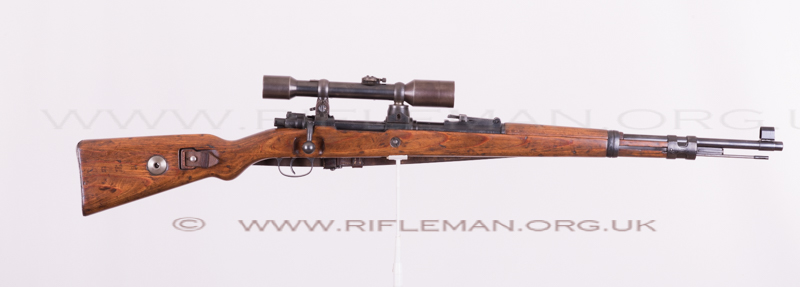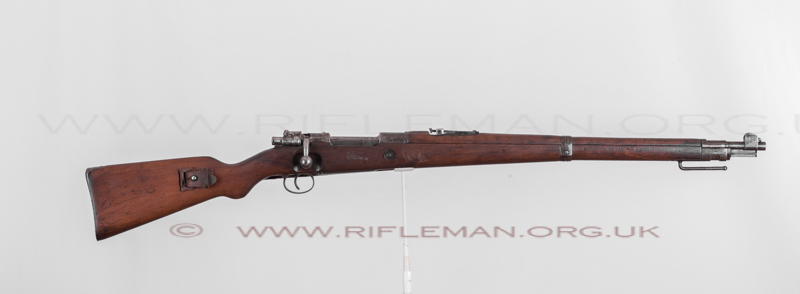A LOW-TURRET SNIPER RIFLE
This first rifle is an unusual model, being a Russian captured rifle
fitted with a low-turret mounted Ajack 4 x 90 telescopic sight on its original mounts.
Parts are therefore non-matching, such rifles having beeen refurbished by the Russians,
and reassembled with generally batched components.
However, the butt-stock is stamped on the LHS with the rifle's serial number,
which has also been electro-pencilled on the bolt body and trigger-guard.
As was the norm with these captured and re-issued rifles,
the Nazi mark beneath the German eagle stamps has been over-punched.
The rifle was manufactured by the Gustloff Werke factory of Weimar in 1942,
with the receiver coded "bcd".
These markings are obscured by the fitment of the front 'scope mount.
It has the flat butt-plate rather than the later cupped version more often seen on such rifles.
These 'scoped rifles came under the generic reference of ZF39 Kar 98s,
as various manufacturers' similar telescopes were all grouped under that nomenclature.
Drag horizontally to rotate subject.
Click to zoom and drag to pan.
Full screen viewing from expansion arrows.
This early model of K98k was illustrated in the manual D134 for the ZF39 rifles

These rifles are thoroughly described in the fine book
"Sniper Variations of the German K98k Rifle"
A Collector Grade Publication by Richard D Law.
Mauser Standard-modell 1937 carbine
In the calibre of 7.92 x 57 mm, a cartridge introduced in 1933,
this rifle was introduced intended mainly for use by German security guards,
although it was also manufactured for export.
This rifle was fitted with the permanent side mount for the small ZF41 telescopic sight. The 'scope was intended as an economical sniping option, and could even be fitted with a loose adapter that snapped into position under the rear-sight's tangent leaf. This was a particularly "make-do" attachment.
The scope itself was of very low magnification, about one-and-a-half times, and had such a small objective lens that light admission was minimal. This meant that the 'scope was of little use in low light conditions. Additionally, the huge 'eye-relief' distance between eye and eye-piece lens led to difficulty in quickly acquiring a target. The configuration was not held in high regard by those to whom it fell to use it.
One of the more well known appearances of the Standard-modell was in the Spanish Civil War, but it was still on issue during WWII along with the Kar9k, with which the former bore a close resemblance. The rifle was also issued to both the paramilitary Sturmabteilung and Schutzstaffel units.
Mauser 1914 K98a carbine
The model used in particular by the German cavalry during the First World War (1914-1918)
The rifle is marked "1.G.D." on the butt-plate tang for the 1st Garde-Dragoner regiment Konigin Viktoria von Gross Britannien und Ireland. This was a title given to an Inhaber – a manner of proprietor in the German and Imperial Austrian armies and not related to the colonel/commander.
There would more usually be two other numbers separated by a dot, e.g. "1.G.D.3.35", which would equate to the 1st Guards Dragoon regiment, 3rd squadron, weapon 35; but such marking is not present on this example.
This particular rifle is also available to view fitted with the Erma Erfurt .22 conversion unit for training purposes.


